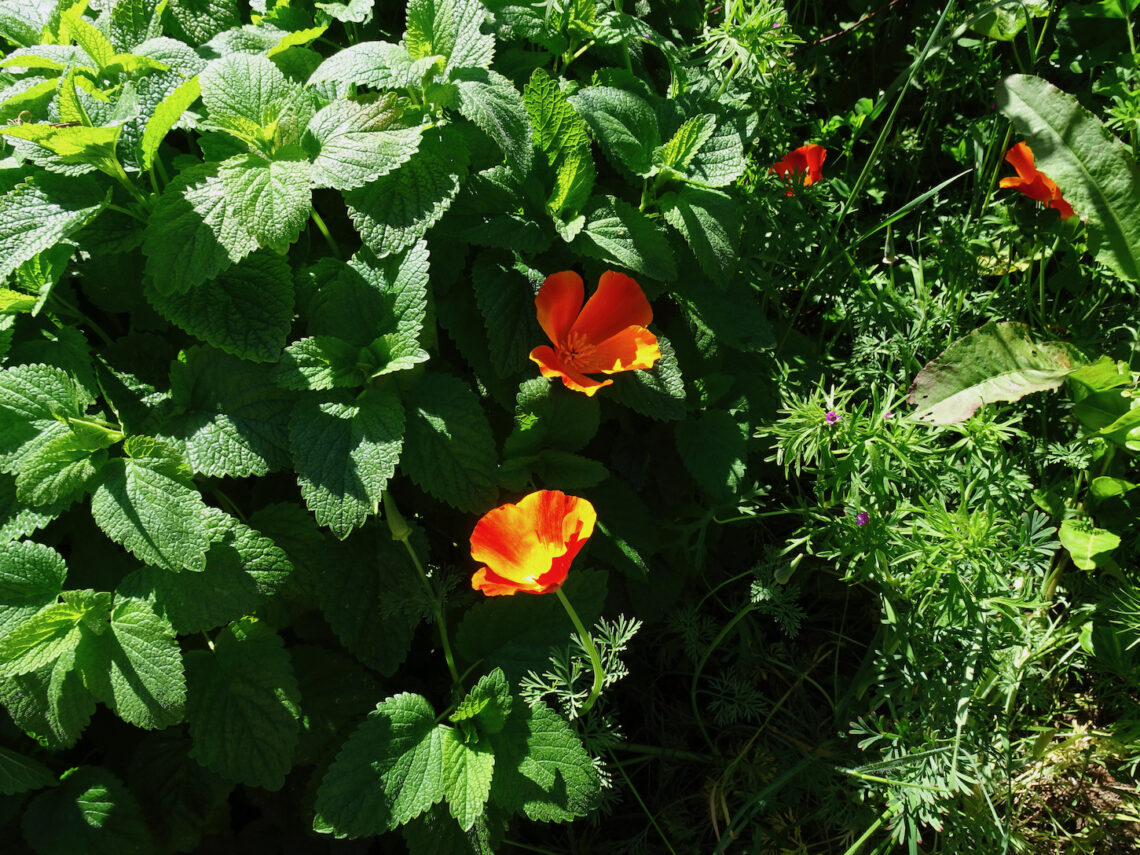
Melissa: Queen of the Bee Haven
It’s just before Imbolc and in the garden, Melissa is thrusting her crinkled, heart-shaped leaves through the cold wet clay with wild abandon. I picked some leaves and made a strong infusion and let it cool, so I can sip on it everyday as I make her acquaintance.
Melissa officinalis, aka Lemon Balm, is a member of the mint family, the Lamiaceae. This is a huge and aromatic family of over 6,000 species, including pennyroyal, peppermint and spearmint, basil, rosemary, sage, thyme, marjoram, oregano, hyssop, horehound and self-heal. Many of these plants are indigenous to Europe and others have found their way here and made themselves at home. Melissa arrived in the second year of the garden, just one plant initially, but now she´s spread herself about, as is her nature and she is most welcome.

Melissa: goddess, bee and plant
In the reality we are creating here in our little patch of paradise, all the plants, trees and animals look out for each other and it´s a great pleasure to learn how to communicate and work together. Melissa is helping us bring in the bees! The plan to make a bee haven fell into place last autumn and we are getting some hives this spring, however, I didn’t recognize Melissa’s initiatory role in this process until I began my research.
The name Melissa is Greek for ´honeybee`, from ´meli`, meaning honey. According to Greek mythology, Melissa, a daughter of Melisseus the king of Crete and a demi-god who taught the use of honey and beekeeping, nursed the infant Zeus, feeding him goat’s milk and honey. In other stories, Melissa the nymph discovered honeycomb and mixed it with water to make a drink and taught others how to do the same, so the bee was named after her and she was appointed their guardian. Then there are the Melissae, (meaning ´bees`) the ancient priestesses of Demeter, Aphrodite, Artemis, Cybele and Rhea, who dressed and danced as bees and are said to have referred to Aphrodite and Artemis as Melissa, the Queen Bee. Bee priestesses still follow this tradition today.
Who was the original Melissa? Was she a goddess, a bee or a plant? Or all three at once? That doesn’t matter and can never be proven anyway. I like the ´Melissa myths` because they highlight the use of creative imagination and the powers of naming, exaltation and invocation. Contrary to popular belief, the naming power does not require knowledge of the ´true` or ´secret name` of anything, which do not even exist. To use the naming power, you only have to satisfy yourself that you have named something, or some one, correctly and she/he/it will naturally respond to your energy, exactly as a ´true name`. You experience this with nicknames and pet names and it is this power that some one once used to name honey, so as to exalt its unique qualities and then to invoke a higher power, a god or goddess of honey to teach its uses.
You name a plant, an animal, a mountain or a secret wild place to enter into a relationship with it and it doesn’t matter whether the name is original or common, so long as you hold it to be true – which is not the same as believing it to be true. There is no heart-opening, no giving and receiving with belief. Naming, exaltation and invocation are useful skills as it becomes increasingly difficult to discover how things work through conventional means. It’s also great fun.
Personally, I prefer the proper name Melissa, to the mundane lemon balm. Exaltation in alchemical terms means to elevate the essence of something to its highest potential, to ennoble it. It doesn’t mean separating spirit from matter, which is impossible, and it doesn’t need laboratory equipment.
I recognized Hekate, the ´Key-holder` at the crescent moon and called on her to show me how to navigate the liminal space between sensory input and the world of ideas, so I could get to know Melissa.
Melissa’s Silent Voice
For at least 2,000 years, it has been known that growing Melissa around hives keeps bees content and helps prevent them from swarming, and it also works to attract new swarms. I’ve transplanted Melissa seedlings from other parts of the garden to the bee haven, so that it will grow as a fragrant carpet under the plane trees, along with rosemary, lavender, cotoneaster, escallonia and abelias. Melissa flowers through summer and into autumn, providing both the nectar and pollen that bees love. Bees find plants like Melissa through sight, smell, electrical fields and pheromones.
Pheromones are part of the invisible network that enables an organic garden to thrive. They are similar to hormones but, whereas hormones are biochemicals that regulate behaviour within an organism, pheromones are released into the atmosphere to communicate with other members of the same species, or even of a completely different species. For example, plants emit pheromones to warn other plants of the same species about insect infestations, so that the forewarned plants can change the chemical constituents of their sap to make themselves more unattractive to the insects. There are alarm pheromones, food trail pheromones, sex pheromones, and many others that affect behavior or physiology. I’m pretty sure plant pheromones regulate human behaviour to some extent too, although the science is still unproven.
The volatile oils of Melissa have a very similar chemical makeup to the bee pheromone Nasonov. Worker (female) bees release Nasonov to call other foraging bees to food sources and to help them find their way back to the hive. Swarming bees also release Nasonov to call the rest of the swarm to the new location. Apparently, humans can smell Nasonov and it has the same pleasant, lemon-mint zing as Melissa. On a warm day, just running your fingers through a Melissa bush releases a fragrance that seems to cause you to inhale deeply and relax…….and then I found myself wondering about the relationship between the bees and Melissa. Out of all the plants in the garden, why does Melissa alone have this specific fragrance? What more does Melissa have to tell? Is odour Hekate`s key?
And what exactly is being unlocked here? Could it be a special tool for the co-creation of your unique life story?
The Key to the OL-factory
What we think of as a single smell is actually a combination of many odor molecules acting on a variety of receptors, creating an intricate neural code that we can identify as the scent of a rose or freshly baked bread. Each odour receptor, located in the olfactory epithelium of the nasal cavity, can be activated by many different odour molecules, and odour molecules can activate several different types of receptors at the same time. However, the some interactions are a better fit than others.
Leslie Vosshall of Rockefeller University, describes it like this:
“Think of a lock that can be opened by 10 different keys. Two of the keys are a perfect fit and open the door easily. The other eight don’t fit as well, and it takes more jiggling to get the door open.”
Our sense of smell is the only one of our senses that connects directly to the limbic system of the brain before going to the thalamus. The limbic system is the gateway to our intuition, memory, emotions, dreams, and higher consciousness. All other senses go to the thalamus first, from where they are routed to specific parts of the cortex for action. The olfactory bulb has direct connections to the amygdala and the hippocampus, where emotions and memories are processed.
This means that a specific smell (an odour engram) is tagged as positive or negative according to previously experienced odour engrams, BEFORE being sent to the thalamus for processing alongside input from the visual, auditory and tactile senses. In this way, what you actually perceive and are able to act upon, has already been filtered according to how you responded emotionally to odours you encountered in the past, whether you are aware of it or not. Smell rules!
This excerpt from an article featuring the work of Sissel Tolaas, a Norwegian artist and researcher who specializes in smell perception and what it reveals about us in the world, illustrates the point perfectly:
“There is nothing either good or bad, but smelling makes it so. The evolutionary purpose of smell, Tolaas says, is to help us find sex partners and food. In both pursuits, humans are widely accepting “generalists”; the only other species as indiscriminate are cockroaches and rats. Given our accommodating natures, we are not hardwired to dislike the smell of perspiration or excrement, she believes. But the cultural practice of censoring so-called bad smells trains people in disgust. Tolaas concedes that some smells are to be avoided because they are harsh or toxic, but insists that the reason we wrinkle our noses at billions of others comes down to simple prejudice.
Smell promotes a life beyond the “blandscape.” An overlooked feature of smell, Tolaas believes, is its capacity to promote joy. “We are born neutral,” she says, and as children we use our noses to encounter each day afresh with an attitude that is naturally open and curious. When we reclaim our true sense of smell, our senses work together in greater harmony. Subliminal impressions are brought to the surface, emotions become more vibrant, and we develop a greater tolerance for things that once disturbed us. “We become more appreciative of life and living,” she insists. Each day Tolaas exercises her nose as compulsively as athletes work their muscles, inhaling different smells to savor their distinctiveness. Her nose has become so sensitive, she says, that she need only breathe when she enters a meeting to assess the mood of the participants and judge how she should behave.
How to retrain your nose. Tolaas vanquishes olfactory prejudices by capturing a smell, cataloguing its molecules and replicating it with her store of 4,000 chemical components. Then she transfers the smell to a new environment, often without identifying what it is. She has observed that subjects who sniff a “bad” smell repeatedly find it gradually changes into an “interesting” one. Afterward, they may show more affection for the source, be it a polluted city or pungent subway car.”
From: How smell shapes our perception of the world around us.
In 2018, neurobiologists at the University of Toronto discovered an additional neural pathway from the olfactory system to the hippocampus, that is involved in a proclivity towards novelty regarding smells. The hippocampus (from the Greek hippos, meaning “horse,” and kampos, meaning “sea monster” because its shape resembles that of a sea horse) is also part of the limbic system, dealing with the formation of new memories and spatial navigation.
According to Afif Aqrabawi, from the Toronto team:
“In other words, we’ve discovered how you are able to remember the smell of your grandma’s apple pie when walking into her kitchen.”
Their research also showed how part of the olfactory system called the anterior olfactory nucleus (AON) plays a vital role in forming what-where-when memories from smells. They found that healthy mice, with all the connections working, preferred to spend energy smelling new odours than familiar ones. They then discovered that they could mimic the odour memory problems seen in Alzheimer’s patients by disconnecting communication between the hippocampus and the AON.
These two commentaries show how SUBJECTIVITY, NOVELTY and PLACE are hardwired into the processing of smell. You can use this functionality to locate yourself in the past and in the spent narrative, or to anchor yourself in the co-creation of your new story, effectively the honing of your soul. As I explained in a previous post, Killing Time with the Quantum Pixies, I find navigation via narrative better than time-related references for the purposes and pleasure of alchemical transformation and regeneration.
You embed yourself in your new story in your chosen location, by paying conscious attention to smells and using them to ´tag` events and experiences. It is subjective, in that your experience and how you feel about it is unique to you, and yet there is another, highly reassuring, factor here to be taken into account, which brings us back to Melissa.
Mother Nature has designed some plants to be beneficial to everyone.
Melissa in Alchemy
Paracelsus revered Melissa above all other herbs and it was a key ingredient in his famed Elixir of Life, along with saffron, celandine and Christmas rose. The complete recipe is unknown, but according to Paracelsus the art of prolonging life is to find and alchemically process the substances that correspond to the essence of human vitality: “Life of man is nothing else than an astral balm, a soothing effect, a celestial and invisible fire, encircled air and a penetrating salty-spirit.” He knew that Nature was not averse to prolonging life and he considered his Elixir of Life to be a universal strengthener of life force and spiritual essence, which he referred to as the Light of Nature, rather than a medicine or a remedy.
The original archetype Melissa embodies is unknown. Some sources, say that Melissa is ruled by Jupiter, others by Venus or the Moon. Paracelsus considered Melissa to be supra-celestial by nature. It is probably closest to the Sun in terms of astrological convention, but the principle here is that Melissa does not conform to a specific planetary vibration. It is a plant that acts on all frequencies.
Hildegard von Bingen (from 1098CE) had a similar perspective:
“Lemon balm contains within it the virtues of a dozen other plants.”
Paracelsus did not get to test his Elixir of Life himself for very long. He lived the lonely peripatetic life of the misunderstood genius, who conveyed wisdom from a different narrative and was unpopular for confronting the orthodoxy of his day. He probably sought solace in the bottle and died in 1541 under suspicious circumstances in the White Horse Inn near Salzburg, Austria, most likely murdered by thugs in the pay of the medical mafia. (Sound familiar?) He was 48 years and 3 days old.
Some of his work on rejuvenation and regeneration survived and it is very much based on his studies of nature and the physical world: “It is not against nature to live for the renewal of the world. It is only that which we are mostly deprived of that is beyond our comprehension…..No one should be astonished and no doctor shall change his colour upon the fact that life can be prolonged.” He understood the archetypal relationship between plants and celestial bodies very clearly and how these can be used to correct imbalances within ourselves.
Two recipes for his Primum Ens Melissa are documented. The Primum Ens is the first entity, whereby the light of nature or life force is said to have been released from the plant into an essence, which when digested can restore lost youth more radically than is usually seen in nature. External conditions are very different today and no one has yet made this elixir successfully.
My focus is on inner alchemy, rather than lab work; my body is the alchemical vessel and the membrane that separates me from the external world is porous. All the processes of alchemy, emerge from the three vibrational levels of nigredo/fungus-putrefaction, albedo/weak life force-palour and rubedo/the rosy-blush of vibrant good health, that take place within the human body. I make changes and I observe how it affects me and the world around me. So the first thing I noticed about Melissa is its smell, which is both uplifting and relaxing. I find the scent of crushed Melissa leaves to be expansive, heart-opening, uplifting and soothing at the same time. The medieval Persian herbalist described said it, “Maketh the heart merry and joyful.” Over time, I feel that it balances the energies between the heart and the mind.
Melissa’s perfume is missing from the Primum Ens Melissa, in fact some of the lab alchemists who have tried to make the essence describe it as having a musty, slightly decaying smell. Given what we now know about the sense of smell, and Melissa’s unique fragrance, I do not see how an essence or tincture of this particular plant can be effective without allowing for the participation of the olfactory system.
“We cannot live in a world that is not our own, in a world that is interpreted for us by others. An interpreted world is not a home. Part of the terror is to take back our own listening, to use our own voice, to see our own light.”
Hildegard von Bingen
Benefits and Uses of Melissa
Melissa infusion: a small handful, 9-13 leaves, will make a pot of tea. Be sure to crush the leaves and smell deeply, before putting them in the pot. Let steep for 15-20 minutes, more if you like a stronger brew. You can drink it hot, with honey if you like, or let cool and chill for a refreshing cold drink. It will keep for up to a week in the fridge. I like to make Melissa and yarrow tea, as the arrow of yarrow guides plant medicine to where its needed most.
The nootropic benefit of Melissa is worth a mention, as it improves brain levels of acetylcholine through an inhibitory effect on acetylcholinesterase, the enzyme that breaks down acetylcholine. Acetylcholine is a neurotransmitter responsible for communication between the nervous system and the musculoskeletal system throughout the body. In the brain it is involved in the formation of memories, verbal and logical reasoning, and the ability to concentrate. Acetylcholine also offers protective benefits and may limit the neurological decay associated with degenerative diseases. Melissa helps improve memory and cognition and is also considered to be neuroprotectant.
The tea is very calming and helps with stress and anxiety, which also contributes to better thinking. It is a cooling nervine and very effective for all kinds of nervous tension, headaches, migraines, heart palpitations, period pain and menopausal issues (it’s especially supportive for women and children) and insomnia. For nervous pain associated with injury or back pain, I think St John’s Wort might be more effective. I have read recommendations for combining St John’s Wort and Melissa, but I haven’t tried that myself.
Melissa is considered safe for children and animals. I’ve given it to Freya sometimes, if she’s been a bit unsettled and it helps her calm down very quickly.
Melissa oil: crush Melissa leaves (don’t forget to sniff them first) to fill a jar, fill with extra virgin olive oil and leave to macerate in a warm-ish dark place for 4-6 weeks. I’m using a yarrow/Melissa blend at the moment and it smells delicious. I rub it over my heart chakra before going to sleep, as I feel it helps me get to sleep quicker and eases some congestion I’ve been experiencing around my heart chakra. Some sources recommend it for the brow chakra too – mind and heart.
Melissa tincture: I haven’t made this yet, but according to Matthew Wood, The Earthwise Herbal: “A tincture of fresh melissa should be on the shelf in every household as a general sedative.”
He says this about the uses of lemon balm:
“Lemon balm has a sour taste, as its name indicates – it is one of the few sour mints. Like most sour plants, it is cooling and sedative. It combines this property with the typical nerve-calming powers of the mint family to make a strong, but safe and simple sedative. These powers are much more marked when the plant is tinctured fresh……..
Melissa is a general remedy in some cases and a specific in others. Although it will generally sedate most people, it is particularly suited to conditions of sympathetic excess, hyperadrenalism, or hyperthyroidism. It is especially indicated when these tendencies are associated with the stomach or the heart. Heart palpitations, atrial fibrillation, high blood pressure and even aneurysm have found a treatment in melissa. It is sometimes combined with Lycopus in hyperthyroidism or is specific by itself. Keynote symptoms include sweaty palms (an indication for nervousness or sympathetic excess), a rapid or superficial pulse, and an elongated, pointed, red tongue.
In addition to being cooling, sedative and calming, melissa is diaphoretic, so it is applicable in fevers with nervousness and in the fevers of young children. It is also used in nervous depression following exhaustive fevers and for convalescence when the digestion has long been irritated.”
Matthew Wood, The Earthwise Herbal
The list of conditions helped by Melissa is too long for me to go into each one, but if you are affected by any of these it might be worth researching Melissa and trying it for yourself:
- thyroid problems (has a balancing effect on both hyper and hypo issues)
- digestive issues
- herpes (topical application)
- liver and heart conditions
- insect bites
- fevers
- anxiety
- insomnia
- detoxification

Itching for a Fright
The Bearings
You May Also Like

Yellow dock root: badger medicine for a new story
April 26, 2019
Perspective on Dog Hind Leg Problems
January 4, 2025
